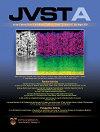Materials characterization: Can artificial intelligence be used to address reproducibility challenges?
IF 2.1
3区 材料科学
Q3 MATERIALS SCIENCE, COATINGS & FILMS
引用次数: 0
Abstract
Material characterization techniques are widely used to characterize the physical and chemical properties of materials at the nanoscale and, thus, play central roles in material scientific discoveries. However, the large and complex datasets generated by these techniques often require significant human effort to interpret and extract meaningful physicochemical insights. Artificial intelligence (AI) techniques such as machine learning (ML) have the potential to improve the efficiency and accuracy of surface analysis by automating data analysis and interpretation. In this perspective paper, we review the current role of AI in surface analysis and discuss its future potential to accelerate discoveries in surface science, materials science, and interface science. We highlight several applications where AI has already been used to analyze surface analysis data, including the identification of crystal structures from XRD data, analysis of XPS spectra for surface composition, and the interpretation of TEM and SEM images for particle morphology and size. We also discuss the challenges and opportunities associated with the integration of AI into surface analysis workflows. These include the need for large and diverse datasets for training ML models, the importance of feature selection and representation, and the potential for ML to enable new insights and discoveries by identifying patterns and relationships in complex datasets. Most importantly, AI analyzed data must not just find the best mathematical description of the data, but it must find the most physical and chemically meaningful results. In addition, the need for reproducibility in scientific research has become increasingly important in recent years. The advancement of AI, including both conventional and the increasing popular deep learning, is showing promise in addressing those challenges by enabling the execution and verification of scientific progress. By training models on large experimental datasets and providing automated analysis and data interpretation, AI can help to ensure that scientific results are reproducible and reliable. Although integration of knowledge and AI models must be considered for the transparency and interpretability of models, the incorporation of AI into the data collection and processing workflow will significantly enhance the efficiency and accuracy of various surface analysis techniques and deepen our understanding at an accelerated pace.材料表征:人工智能可以解决可重复性的挑战吗?
材料表征技术被广泛用于表征纳米尺度材料的物理和化学性质,因此在材料科学发现中起着核心作用。然而,这些技术产生的庞大而复杂的数据集通常需要大量的人力来解释和提取有意义的物理化学见解。机器学习(ML)等人工智能(AI)技术有可能通过自动化数据分析和解释来提高表面分析的效率和准确性。在这篇前瞻性的论文中,我们回顾了人工智能在表面分析中的作用,并讨论了它在加速表面科学、材料科学和界面科学发现方面的未来潜力。我们重点介绍了人工智能已经用于分析表面分析数据的几个应用,包括从XRD数据中识别晶体结构,分析表面成分的XPS光谱,以及解释颗粒形态和尺寸的TEM和SEM图像。我们还讨论了将人工智能集成到表面分析工作流程中的挑战和机遇。其中包括训练机器学习模型需要大型和多样化的数据集,特征选择和表示的重要性,以及机器学习通过识别复杂数据集中的模式和关系来实现新见解和发现的潜力。最重要的是,人工智能分析数据不仅要找到数据的最佳数学描述,还必须找到最具物理和化学意义的结果。此外,近年来,科学研究中对可重复性的需求变得越来越重要。人工智能的进步,包括传统的和日益流行的深度学习,正在显示出通过执行和验证科学进步来应对这些挑战的希望。通过在大型实验数据集上训练模型并提供自动分析和数据解释,人工智能可以帮助确保科学结果的可重复性和可靠性。虽然为了模型的透明度和可解释性,必须考虑知识和人工智能模型的集成,但将人工智能纳入数据收集和处理工作流将大大提高各种表面分析技术的效率和准确性,并加速加深我们的理解。
本文章由计算机程序翻译,如有差异,请以英文原文为准。
求助全文
约1分钟内获得全文
求助全文
来源期刊

Journal of Vacuum Science & Technology A
工程技术-材料科学:膜
CiteScore
5.10
自引率
10.30%
发文量
247
审稿时长
2.1 months
期刊介绍:
Journal of Vacuum Science & Technology A publishes reports of original research, letters, and review articles that focus on fundamental scientific understanding of interfaces, surfaces, plasmas and thin films and on using this understanding to advance the state-of-the-art in various technological applications.
 求助内容:
求助内容: 应助结果提醒方式:
应助结果提醒方式:


